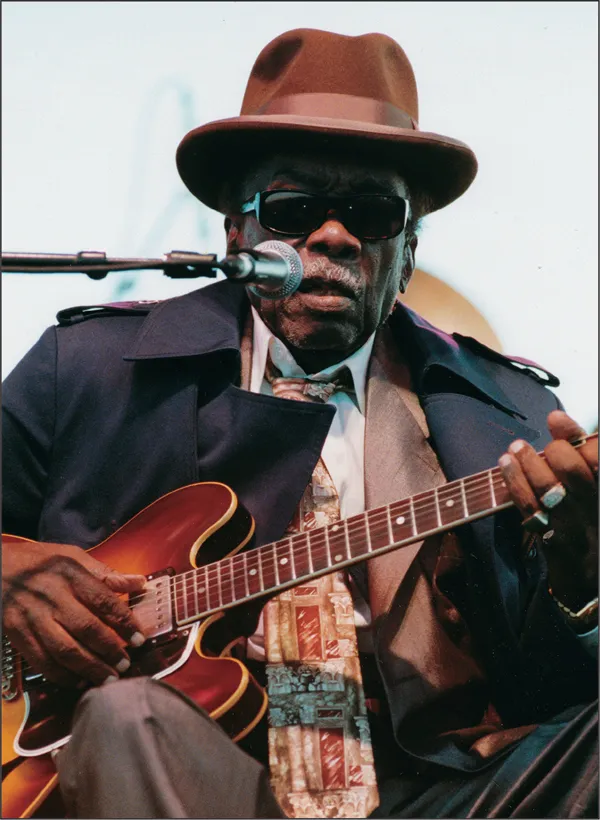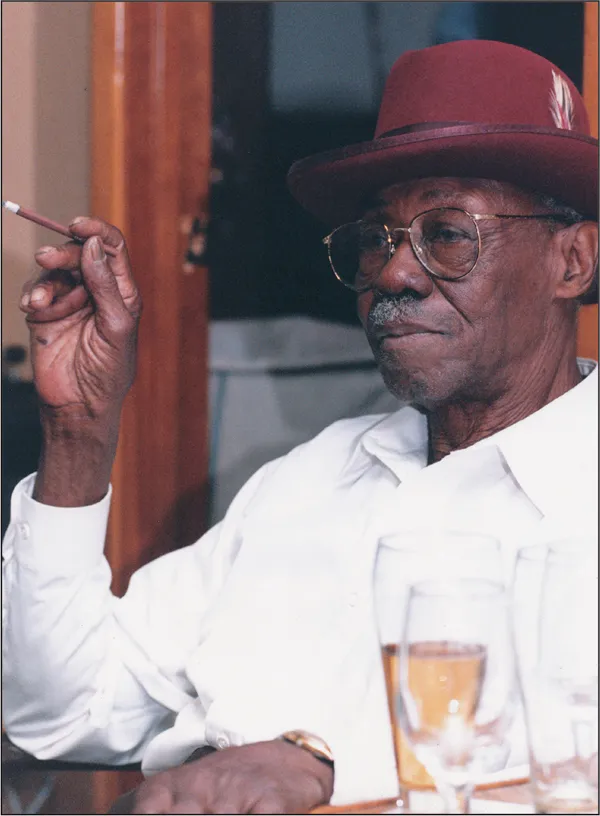![]()
One
THE LAST OF THE GREAT MISSISSIPPI DELTA BLUES MUSICIANS
ROBERT LOCKWOOD JR. AND PINETOP PERKINS, CLEVELAND, OHIO, 1998. Robert Lockwood Jr. (left) and Joe Willie “Pinetop” Perkins were two of the last great Delta blues musicians. They both appeared on King Biscuit Time, a live radio program in the 1940s on KFFA in Helena, Arkansas. Lockwood, on electric guitar, played with harp great Sonny Boy Williamson II in 1941. Perkins later joined the original band on piano. This program was the first to broadcast live blues heard throughout the Mississippi Delta region.
DAVID “HONEYBOY” EDWARDS, CHICAGO, 1998, AND CLEVELAND, OHIO, 2000. Throughout his 80-year career, David “Honeyboy” Edwards was the embodiment of the rambling, itinerant blues musician. Born in Shaw, Mississippi, in 1915, he remained true to the original Delta blues style. He learned to play from his father, Henry Edwards, and blues pioneers Charley Patton and Tommy Johnson. He traveled throughout the South playing in juke joints with Robert Johnson, Big Joe Williams, Tommy McClennan, Sonny Boy Williamson II, and Big Walter Horton. He was with Robert Johnson on the night of his final performance in August 1938, when Johnson was allegedly poisoned in Greenwood, Mississippi. Folklorist Alan Lomax recorded him in 1942 for the Library of Congress in Clarksdale. Edwards continued to tour well into his nineties, carrying the torch for the Delta blues into the 21st century.
JOHN LEE HOOKER, CHESAPEAKE BAY BLUES FESTIVAL, 1999. John Lee Hooker, “the King of the Delta Boogie,” was one of the blues’ most influential performers. His pulsating, rhythm-based guitar and distinctive vocals resonated with blues and rock audiences for six decades. Hooker was born to sharecroppers near Clarksdale, Mississippi, in 1917, although there are contradictory details about his early life. His father was a preacher, and spiritual music was his early influence. At age 14, he ran away to live with his stepfather Will Moore, a blues musician, who was a major factor in his playing style. By the early 1940s, Hooker moved to Detroit, by way of Memphis and Cincinnati. In 1948, he released his seminal debut “Boogie Chillen.” The hypnotic-grooves on “Crawlin’ Kingsnake,” “I’m in the Mood,” and “Boom Boom” struck a chord with British rock bands in the 1960s, helping fuel the British Invasion and a blues resurgence in America.
ROBERT LOCKWOOD JR., CHICAGO, 1999. Robert Lockwood Jr. was a blues innovator and one of the last great Delta blues musicians. A pioneer in the development of electric guitar, he introduced a jazzy inflection with more complex chord structures into the blues. Born in 1915 on a farm in Turkey Scratch, Arkansas, near Helena, Lockwood was a direct link and the only student of the legendary Robert Johnson, who was his stepfather. He made his first recordings on Bluebird in 1941. He was the first electric guitarist to be heard on live radio in the Delta, playing on King Biscuit Time with Sonny Boy Williamson II in 1941 on KFFA in Helena, Arkansas. Lockwood was a well-known session player in Chicago in the 1950s for Sonny Boy Williamson II, Little Walter, Willie Dixon, and Otis Spann. He was a mentor to B.B. King and the Delta’s first modern lead guitar player. He was inducted into the Blues Hall of Fame in 1989.
ROBERT LOCKWOOD JR. AT HOME, CLEVELAND, OHIO, 1998. Robert Lockwood Jr. patterned his early style on Robert Johnson’s playing intricacies in the 1930s. He took Johnson’s intense polyrhythmic style and incorporated jazz elements, creating his own unique phrasing of traditional blues. His blues standards include “Little Boy Blue,” “Take a Little Walk With Me,” and “Black Spider Blues.”
HONEYBOY EDWARDS AND ROBERT LOCKWOOD JR., CLEVELAND, OHIO, 2000. David “Honeyboy” Edwards (left) and Robert Lockwood Jr. were two of the last great Delta blues musicians, both with direct links to the legendary Robert Johnson. Edwards played and traveled with Johnson in the Mississippi Delta in the 1930s. They both relocated to Chicago in the 1950s.
PINETOP PERKINS, POCONO BLUES FESTIVAL, 1999, AND CLEVELAND, OHIO, 1998. Joe Willie “Pinetop” Perkins was one of the blues’ greatest pianists. His boogie-woogie, barrelhouse style made him one of the blues’ best modern piano players. He was born in 1913 in Belzoni, Mississippi, where he worked in plantation cotton fields. A knife attack severed tendons in his arm in 1943, forcing him to switch from guitar to piano. Perkins traveled to Helena, Arkansas with Robert Nighthawk in 1943, where he played on the King Biscuit Time radio show on KFFA with Sonny Boy Williamson II. “Pinetop’s Boogie Woogie,” recorded at Sun Records in 1953, became Perkins’s signature tune. The original version was done by Pinetop Smith in 1928. His session work included Nighthawk, Earl Hooker, Little Milton, and Albert King. He replaced Otis Spann for a stint in Muddy Waters’s last great band in 1969. He won a Grammy Award for “Joined at the Hip” with Willie “Big Eyes” Smith in 2011.
SNOOKY PRYOR, POCONO BLUES FESTIVAL, 1999. James Edward “Snooky” Pryor was a pioneer in amplified Chicago blues harmonica. Born in Lambert, Mississippi, in 1921, he began playing harmonica as a child. Pryor developed his piercing style in the Delta before moving to Chicago in 1940. He is believed to be the first harp player to amplify his sound by cupping a harmonica and microphone in his hands through a public address (PA) s...











